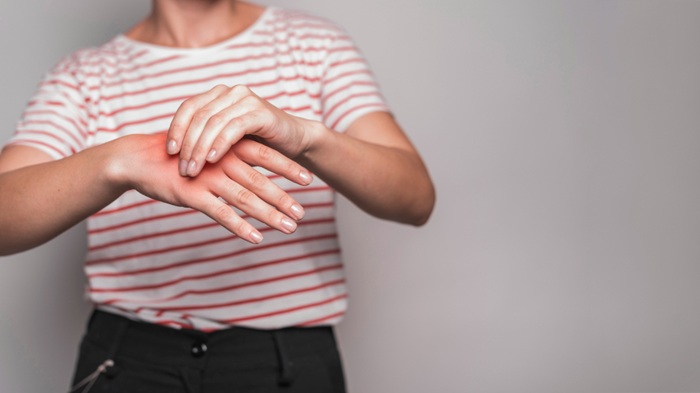A contracture is a structural change in soft tissue and connective tissue that makes the affected area stiff, tight, and shortened. Tissues affected by contractures lose their natural elasticity and range of motion.
Contractures are a form of scarring within the tissue. This condition is most noticeable when it affects the skin. For example, in people with severe burns, the affected skin may shrink and tighten.
Contents
Types of Contractures
Different types of contractures can affect various tissues or body parts. Medical professionals use several terms to describe them, including:
- Scar contracture: Occurs on the skin after injury and scar formation. Scar contractures can trigger other types of contractures if they interfere with the normal movement of tissues or joints.
- Muscle contracture: Affects a single muscle or a group of related muscles. Muscle contractures can also cause joint contractures by restricting normal movement.
- Joint contracture (capsular contracture): Affects the connective tissue surrounding bones within a joint (joint capsule). When the capsule becomes stiff, the bones cannot move freely.
- Arthrogenic contracture: A joint capsule contracture originating directly from the joint itself. A joint capsule contracture can easily affect connected muscles, and conversely, muscle contractures can affect the joint.
Specific Types of Contractures
Some contractures have specific names, including:
- Amyoplasia: A congenital condition involving multiple contractures in a newborn’s limbs.
- Arthrogryposis: A general term for babies born with multiple contractures, which can be part of various genetic disorders such as muscular dystrophy or Edwards syndrome.
- Clubfoot: A congenital contracture affecting tendons in a baby’s foot, causing the foot to turn inward; may also involve calf muscles.
- Dupuytren’s contracture: A genetic condition that causes soft tissue contractures in the hand, gradually bending one or more fingers toward the palm.
- Elbow contracture (stiff elbow): Contracture of the elbow joint capsule.
- Equinus contracture: Affects the ankle joint or connected muscles, preventing the foot from being positioned at a right angle to the leg.
- Flexion contracture: A type of joint contracture where the joint remains bent and cannot be straightened, most often occurring in the limbs.
- Frozen shoulder (adhesive capsulitis): Contracture of the shoulder joint capsule.
- Volkmann’s contracture: A hand contracture causing the fingers and wrist to bend inward, giving the hand a claw-like appearance.
Symptoms of Contracture
Symptoms may include:
- Noticeable thickening and tightening of scar tissue
- Stiffness in muscles, joints, or other soft tissues
- Musculoskeletal pain in soft tissues
- Reduced range of motion and mobility
- Muscle atrophy (loss of muscle mass)
- Abnormal gait (walking pattern)
- Permanent flexion deformity, especially in the limbs
Causes of Contracture
Contractures are a form of scar tissue or fibrosis within the body’s tissues. They usually occur when tissue tries to repair itself after injury or shrinks due to disuse. In some cases, contractures are present at birth.
Common causes include:
- Injury: Major tissue loss from burns, infected wounds, or surgery can lead to scarring and shrinking of skin or soft tissue.
- Ischemia: Reduced blood flow to tissue can cause chronic inflammation followed by scar tissue formation.
- Immobilization: The most common cause of soft tissue contracture, often due to injury, physical disability, or neurological conditions.
- Neuromuscular disorders: Conditions like stroke and cerebral palsy disrupt brain-muscle communication, leading to stiffness or excessive muscle contraction (hypertonia).
- Congenital connective tissue disorders: Such as congenital myopathy, which can cause muscles to be overly stiff or weak.
- Birth defects: Some babies are born with contractures without a clear medical cause, possibly due to genetic mutations or reduced movement in the womb.
Possible Complications
Permanent contractures can severely impact quality of life, limiting mobility and independence. They can also trigger chronic pain and create a chain reaction affecting connected muscles and joints. Reduced movement increases the risk of further tissue tightening.
Diagnosis
If you are at risk for contracture due to injury or certain conditions, medical professionals will monitor for warning signs. Diagnosis is typically made through a physical examination to assess range of motion.
Imaging tests such as X-rays, ultrasound, or MRI may be used to evaluate connective and soft tissue involvement.
Treatment for Contracture
The best treatment is prevention. In many cases, contractures can be avoided with early intervention. Physical therapy is often recommended for those at risk.
If a contracture is already present, treatment should start as early as possible. Early-stage contractures are often milder and respond better to non-surgical options, while advanced contractures may require surgery.
Non-Surgical Treatments
- Static and dynamic stretching: Using braces, casts, or splints to gradually stretch contracted tissues.
- Heat therapy: Applying therapeutic heat to relax muscles, improve flexibility, and enhance blood circulation.
- Physical therapy: Active and passive exercises to improve flexibility, range of motion, and prevent muscle atrophy.
- Myofascial release therapy: A massage technique targeting fascia (connective tissue under the muscles) to prevent and treat contractures.
- Injections: Intra-articular or soft tissue injections such as Botox® for muscle relaxation or collagenase to break down fibrotic tissue.
- Anti-inflammatory treatment: Medications or therapies like low-level laser (infrared light) to reduce inflammation and fibrosis risk.
Surgical Treatments
- Tenotomy (tendon lengthening): Making small incisions in the tendon to reduce tension, allowing it to lengthen during healing.
- Tendon transfer: Replacing the contracted tendon with one from a donor or another body part.
- Arthroplasty: Releasing or replacing part of a joint capsule, or in some cases, replacing the entire joint.
- Fasciotomy: Cutting the fascia to release tension, often used for Dupuytren’s contracture.
- Z-plasty: A zig-zag incision technique to release skin and fascia contractures while reducing the risk of recurrence.
- Plastic surgery: Removing damaged scar tissue and replacing it with skin grafts or flaps from a donor or another body area.
Expert Plastic Surgery Care for Contracture at Mandaya Royal Puri Hospital

Mandaya Royal Puri Hospital has a team of experienced plastic surgeons who specialize in treating contractures, including those caused by burns.
One of the specialists available is dr. Sara Ester Triatmoko, Sp.B.P.R.E., Subsp.M.O. (K). Recently, dr. Sara successfully performed a contracture release surgery for a burn patient’s hand, restoring its function.
Clinic schedule at Mandaya Royal Puri Hospital:
- Tuesday: 4:30 PM – 8:00 PM
- Thursday: 4:30 PM – 8:00 PM
For easy access to care, you can contact the hospital via WhatsApp Chat, use the Book Appointment feature, or download the Care Dokter app on Google Play or the App Store to check queue numbers, manage visits, and access more information.



